A Broadwell Retrospective Review in 2020: Is eDRAM Still Worth It?
by Dr. Ian Cutress on November 2, 2020 11:00 AM ESTGaming Tests: Chernobylite
Despite the advent of recent TV shows like Chernobyl, recreating the situation revolving around the 1986 Chernobyl nuclear disaster, the concept of nuclear fallout and the town of Pripyat have been popular settings for a number of games – mostly first person shooters. Chernobylite is an indie title that plays on a science-fiction survival horror experience and uses a 3D-scanned recreation of the real Chernobyl Exclusion Zone. It involves challenging combat, a mix of free exploration with crafting and non-linear story telling. While still in early access, it is already picking up plenty of awards.
I picked up Chernobylite while still in early access, and was impressed by its in-game benchmark, showcasing complex building structure with plenty of trees and structures where aliasing becomes important. The in-game benchmark is an on-rails experience through the scenery, covering both indoor and outdoor scenes – it ends up being very CPU limited in the way it is designed. We have taken an offline version of Chernobylite to use in our tests, and we are testing the following settings combinations:
- 360p Low, 1440p Low, 4K Low, 1080p Max
We do as many runs within 10 minutes per resolution/setting combination, and then take averages.
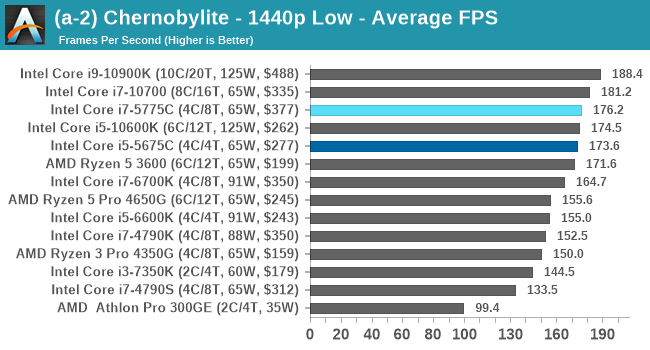
| AnandTech | Low Res Low Qual |
Medium Res Low Qual |
High Res Low Qual |
Medium Res Max Qual |
| Average FPS | 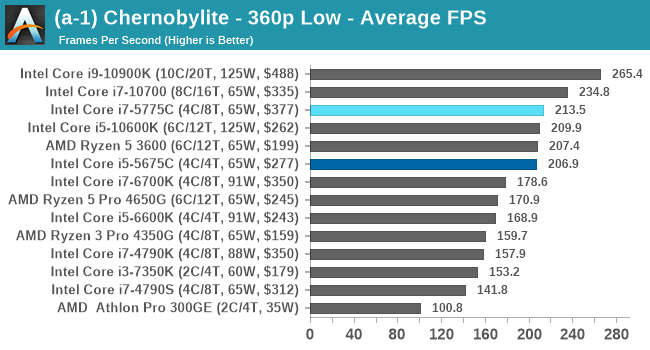 |
 |
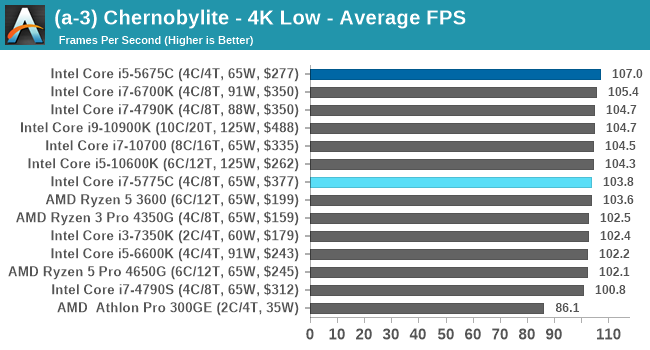 |
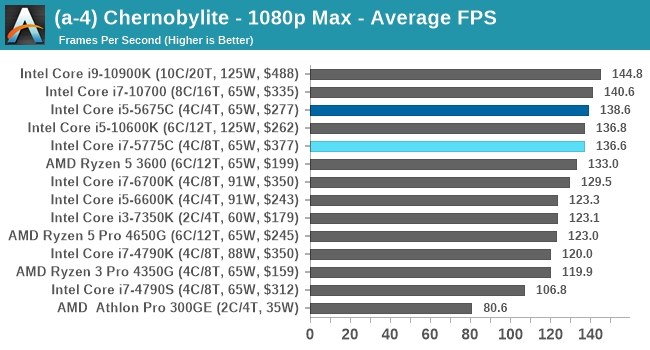 |
The Broadwell CPUs remain high performers here as the frame rates get cranked up, with the Broadwell Core i7+i5 even matching the latest Comet Lake Core i5, even at 1080p Max settings.
For our Integrated Tests, we run the first and last combination of settings.
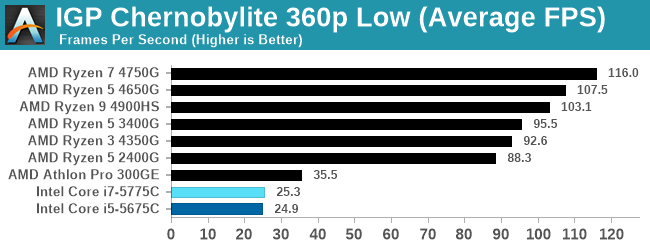
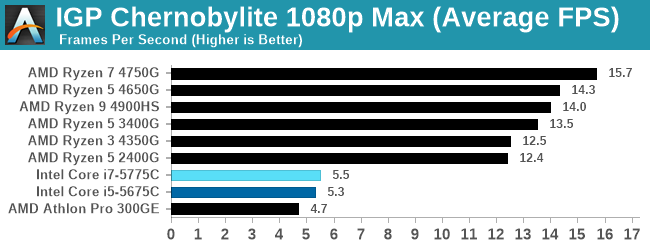
Integrated graphics shows how far AMD's basic options are ahead.











120 Comments
View All Comments
Jorgp2 - Monday, November 2, 2020 - link
Why didn't he buy it then?There was even a many lake refresh
Oxford Guy - Wednesday, November 4, 2020 - link
He didn’t buy a desktop high TDP Skylake with EDRAM because it was never produced. Intel decided to sell less for more, which it could so safely since our capitalist system is mainly about a near-total lack of competition far more often (in tech at least) than anything else. Read for comprehension.Oxford Guy - Monday, November 2, 2020 - link
So, the take-away here is that Intel was heavily sandbagging — not bothering to take advantage of the benefit EDRAM provides (for gaming especially).$10 worth of parts and gamers were expected for fork over big money for less performance.
Hooray for lack of competition.
Nictron - Tuesday, November 3, 2020 - link
My i7 5775c died last week after 4.5 years of service at OC 4.1-4.2 Ghz. Now seeing this review I am quite sad as it could’ve gone a bit more.Upgraded to R5 3600XT for now and can always go 5000 series in future on the X570 platform.
Hope competition stays strong!
Oxford Guy - Wednesday, November 4, 2020 - link
You can hope or you can look at the facts. It hasn’t been strong. That’s why Intel was able to sandbag so extremely.alufan - Tuesday, November 3, 2020 - link
The Intel skew on this site is getting silly its becoming an Intel promo machine!You Benchmark but like many Laptop providers you hamstring the AMD CPU with the worst and slowest components, we all know Ryzen CPUs work best with fast RAM in fact you have stated so yourselves in the past on this very site yet you now choose to test the Ryzen option with CL22 bargain basement RAM..... makes me wonder, how much did Intel pay for this review of a 5 year old CPU just to keep the Blue option at the top of the page, Anandtech is a shameful parody of a neutral review site and frankly the owners and editors have exchanged integrity for well whatever you want to call it, shame on you
Ian Cutress - Tuesday, November 3, 2020 - link
I test at JEDEC speeds. For Ryzen that's DDR4-3200, and JEDEC subtimings are CL22. If you want to complain, complain to JEDEC to ask for something faster, or ask companies to validate memory controllers beyond JEDEC standards. Otherwise it's overclocking, and if we're overclocking, then who cares about core frequency or power anyway.https://www.youtube.com/watch?v=jQe5j7xIcog - I even did a video on it.
I do tons of AMD coverage. Year in year out interviews of CEO and CTO of AMD, but no equivalent of Intel. Deep dives into every major architecture, with analysis of instruction performance as well as cache hierarchy. Reviews of almost every single Ryzen product, as we're sampled most of them. If we were that big of an Intel shill, why does AMD supply us what we ask for?
alufan - Tuesday, November 3, 2020 - link
Ahh so the Ram kit you used for the Intel test just happened to fall into the slots then with its CL16 is that JEDEC standard?I dont want any particular preference shown to either Brand I will admit however to not liking Intel due to former poor experience but I think its important when charts and such are published that a level field is used, because at some point somebody may well use those published figures as a illustration of one products superiority over another, Intel is very good at doing just that, and I will cite the last Thread ripper release for that one just so they could have a set of tables showing the Intel product on the Top even if it was for a few hours.
qwertymac93 - Tuesday, November 3, 2020 - link
Where did you find the latency settings the tests were performed at? I didn't see the latencies mentioned in the test setup page.alufan - Tuesday, November 3, 2020 - link
"Where did you find the latency settings the tests were performed at? I didn't see the latencies mentioned in the test setup page."look up the parts on the makers website